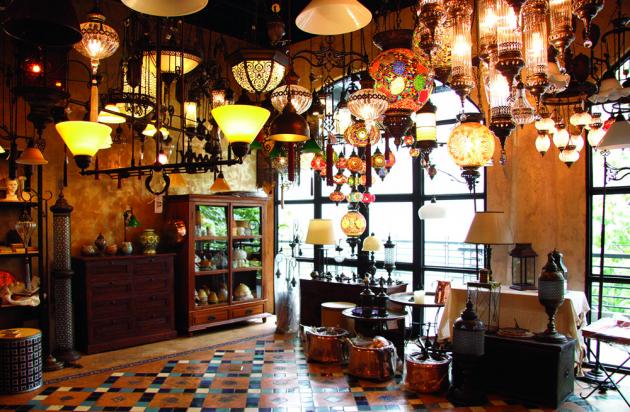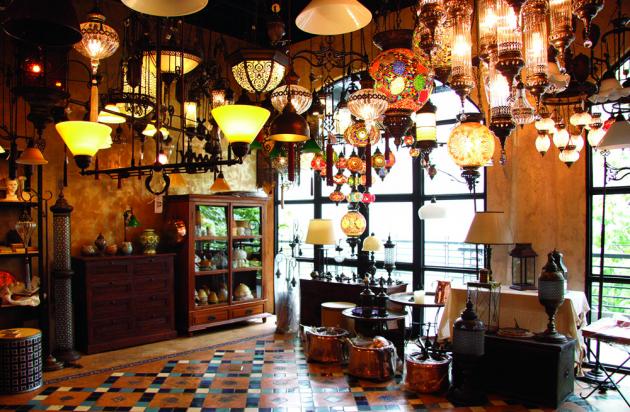Turkish Mosaic Lamps Emerge From Under the Tiffany Shadow
The mosaic as an art form goes back to the days of Mesopotamia where artisans used different color stones to create decorative patterns and scenes of everyday life. The practice survived into Hellenistic times and was then picked up by the Romans who refined the process and added other elements like colored glass into the mix. After the collapse of the Western Roman Empire mosaics found a longer lasting home in the Eastern or Byzantine Empire. Over a thousand years from the 6th through the 15th centuries the Byzantines employed mosaics for decorative, religious and of course political purposes to stunning effect.
Before there was Tiffany...
Following the fall of Constantinople in 1453, Ottoman craftsmen used mosaics to create elaborate, decorative patterns that expanded the vocabulary of the art form. While an exact date cannot be affixed with any certainty it was the 19th century that saw the appearance in Turkey of the first mosaic lampshades. The idea was soon co-opted by Louis Comfort Tiffany who, in a nod to the land of its origin, felt the best way to introduce his “new” style of lamp to a Western clientele was to display them in a Byzantine style chapel at the 1893 World Columbian Exposition in Chicago. The cross culture ploy worked and in short order “Tiffany lamps” were taking the American and European markets by storm. Meanwhile the craftsmen of Turkey continued to labor away producing lamps of astonishing quality that were little known outside their own geographical neighborhood.
Separation and Refinement
If you’ve ever seen a true Tiffany lamp you know how they quietly command attention. Turkish mosaic lamps are no different in that regard. Where the two makes of lamp diverge is in the area of pattern work. Turkish mosaic lamps tend to be more colorful and visually expressive, but no less refined. They typically employ many traditional Ottoman geometric motifs such as you’ll still see today in wall and floor tiles, carpeting and jewelry throughout Asia Minor. This type of Turkish lamp - whether wall lamps, ceiling lamps, pendants or Turkish table lamps - also embody a more handcrafted look and feel that makes them, in the opinion of many, less pretentious and culturally distant than their Tiffany counterparts.
Affordability
Anyone who has ever researched the price of authentic antique Tiffany lamps knows that they typically start around $5,000. Some have fetched more than $1 million at auction. Even the somewhat watered down versions available today under the Tiffany name will still cost several hundred dollars and more. Their Turkish counterparts by contrast are not weighed down (and marked up) by consumer fascination with a particular brand name. As such you’re not paying for the name, only the object itself which, in the case of Turkish mosaic lamps, are generally considered to be a higher quality product than what is being mass-produced today under the Tiffany moniker.
Availability
Peruse a site like Pinterest and you’ll discover many people who have posted photos and comments about the amazing hand crafted lamps they’ve found in the out of the way shops and public bazaars of Turkey. If you dig down into the site a bit you’ll see topics like “Top travel-inspired ideas” and “Affordable decorating ideas from the Grand Bazaar” that go on to describe the excitement and pleasure travelers experience when they first encounter these lamps. Fortunately today you don’t have to travel to the far reaches of Asia Minor to bring home breathtaking quality and stunning designs.
Trust Paykoc to Find the Highest Quality Mosaic Lamps Available
As connoisseurs of high quality, hand crafted items Paykoc Imports has scoured the workshops of Turkey for you to find the most dazzling mosaic lamps being made anywhere today. Our goal is to introduce the Western audience to these amazing objects d’art and to help shine a well-deserved light of recognition on the Turkish craftsmen and women who have toiled in virtual obscurity for decades creating them.
Every mosaic lamp we sell embodies centuries of tradition and is a physical manifestation of the notion that quality workmanship is still alive and still affordable. Our sales staff are some of the most knowledgeable mosaic lamp experts at work in the field today. They know which Turkish workshops produce top-of-the-line lamps and which produce the knock-offs intended for tourist consumption. They carefully assess the aesthetic and material qualities of each piece so that when you buy a pendant or mosaic table lamp from Paykoc you can be confident you’re investing in an object that will fulfill both a practical and decorative function for years to come.
We at Paykoc consider it nothing less than a privilege to introduce our valued customers to the world of Turkish mosaic lamps: The culturally significant, high quality, affordable alternative to Tiffany.
For more information on how to add your mosaic lamp into your home check out our integration guide

 Default Currency
Default Currency

